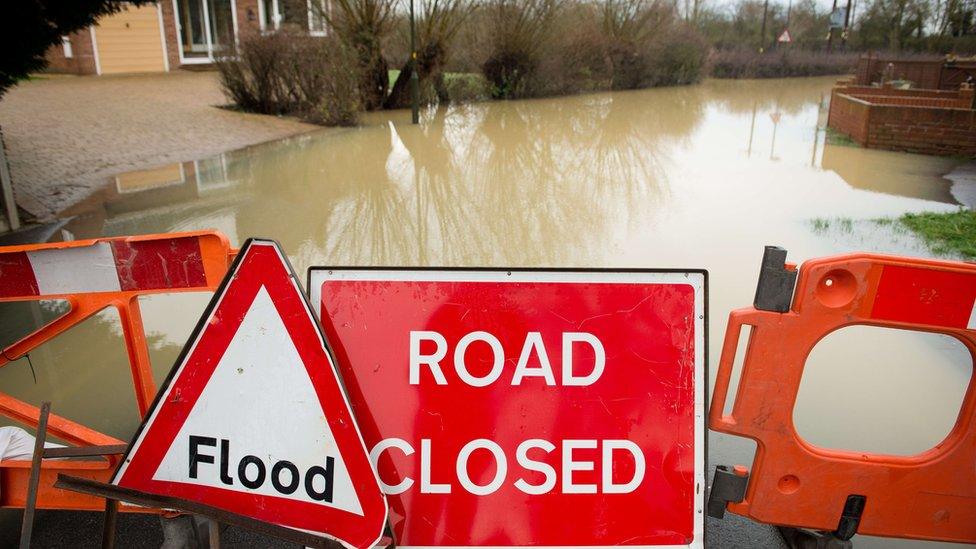Hundreds of key sites in England at risk of floods
- Published

The Army was called in to help protect homes against floods last year
As many as 530 key infrastructure sites across England are still vulnerable to flooding, according to a government review.
The report, external commits a total of £12.5m to new temporary flood defences in England.
The review was commissioned after 16,000 houses across northern England were flooded during the wettest December in a century last year.
Critics at the time said defences were not up to the job.
The £12.5m means the Environment Agency would have four times as many temporary flood barriers than in 2015.
Environment Secretary Andrea Leadsom said the review set out "clear actions so we are better prepared to respond quickly in the event of future flooding and can strengthen the nation's flood defences".
She added: "Work is already underway towards £12.5 million of new temporary defences stationed around England, better protection for our infrastructure and new flood modelling that makes better use of data and technology."
She also said the government was investing £2.5bn by 2021 to protect families, homes and businesses from flooding.
Other recommendations from the review include:
A commitment from utility companies to increase flood protection of their key local infrastructure, such as phone networks and water treatment works.
A new stress test of the risk of flooding from rivers and the sea in England. For the first time, Met Office forecasts of extreme rainfall scenarios will be linked with Environment Agency modelling to provide a new assessment of flood risk.


Analysis - David Shukman, BBC Science Editor
Ministers offer communities the prospect of better protection from flooding but the report lays bare the scale of the work needed to achieve that. What does not appear in the press release accompanying the report is what many would judge to be the key finding: that as many as 530 important infrastructure sites across England - water supplies, telecommunications systems and electricity networks - are still vulnerable.
And a fair question is what happens in the immediate future. The Met Office concludes that even without the effects of climate change, storms like those last winter could bring even greater volumes of rainfall - nearly one-third more in some cases. So I asked the Environment Agency if a city like Carlisle, inundated badly last December, would be any safer this winter. Not really, came the answer, reluctantly.
The new temporary barriers would not hold back the 2m of floodwater seen last winter. The hope for the moment is that vulnerable homes have been fitted with the latest protection systems. The uncomfortable truth is that it's impossible to defend everyone all the time. But no one in authority particularly likes to say so.

Sticking plaster?
The National Flood Resilience Review was set up after devastating floods last winter across parts of northern England.
Its aim was to assess how the country could be better protected from future flooding and increasing extreme weather.
During storms last December in parts of northern England, flood defences did not work in some places, forcing thousands of people from their homes over Christmas.
Dr Stephen Gibbs, chairman of the Carlisle Flood Action Group, who lives in the Cumbrian city and has been flooded twice, was critical of the Government's approach.
"The issue is Government statutory powers to say 'we will defeat flooding'," he explained.
"The Environment Agency [EA] have a pattern - they have a flood, they have a review, then they get out the [sticking plaster] and hope for the best until the next flood.
"Temporary flood defences are part of the filibustering that the EA are having to do. The Dutch defeated flooding because their senior politicians sat down and said 'How can we defeat this?' And they defeated flooding."
The report itself notes that just 30-40% of locally important infrastructure sites might be suitable for protection with appropriate temporary defences.
Leeds City Council leader Judith Blake said: "Leeds is barely mentioned in this report, which really does smack of the Government not taking the risk here seriously.
"Storm Eva caused absolute devastation for residents and businesses in Leeds, with many still recovering.
After the floods, Ms Blake argued that there was a North-South divide in the response.
"As we know to our cost, there has been a severe lack of long-term planning when it comes to funding for flood defences and there is nothing in this report to offer comfort on that level," she said.
Cllr Martin Tett, environment spokesman for the Local Government Association (LGA) said the £12.5m was a step "in the right direction".
He added: "Future funding for flood defences must also be devolved by the government to local areas. This will enable councils, working with communities and businesses, to ensure money is directed towards projects that best reflect local needs."